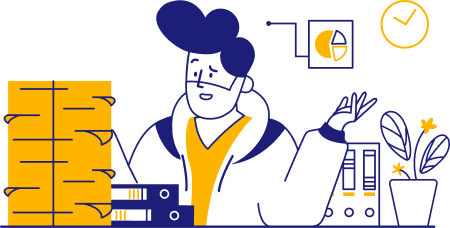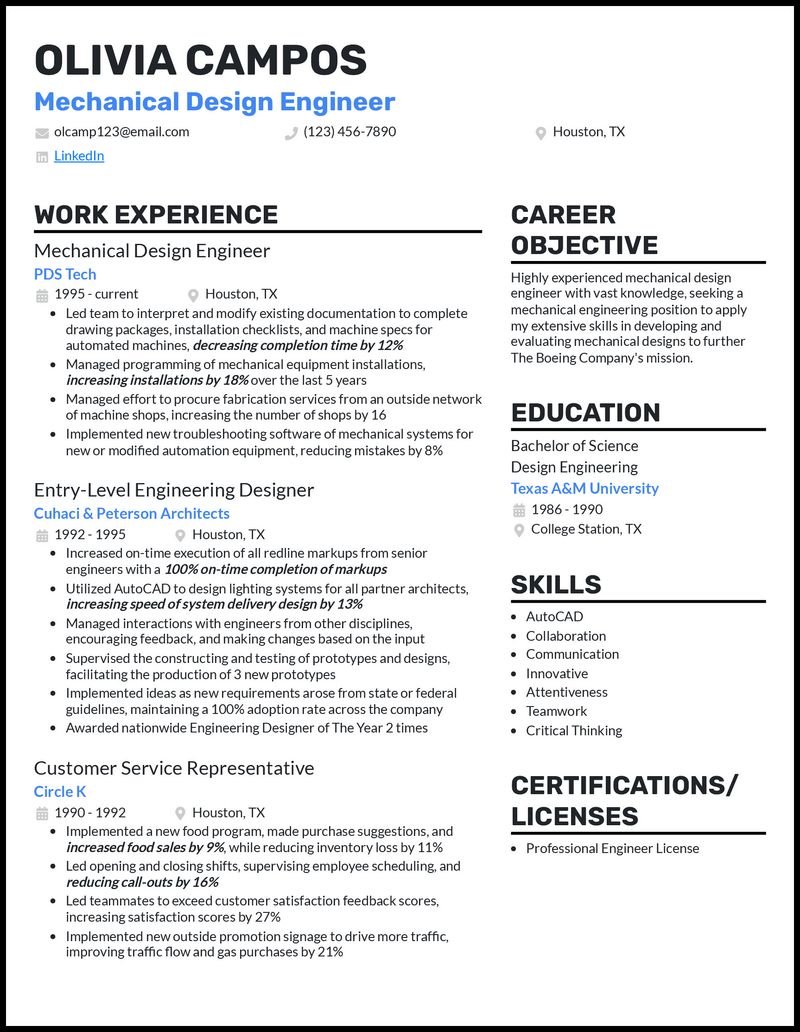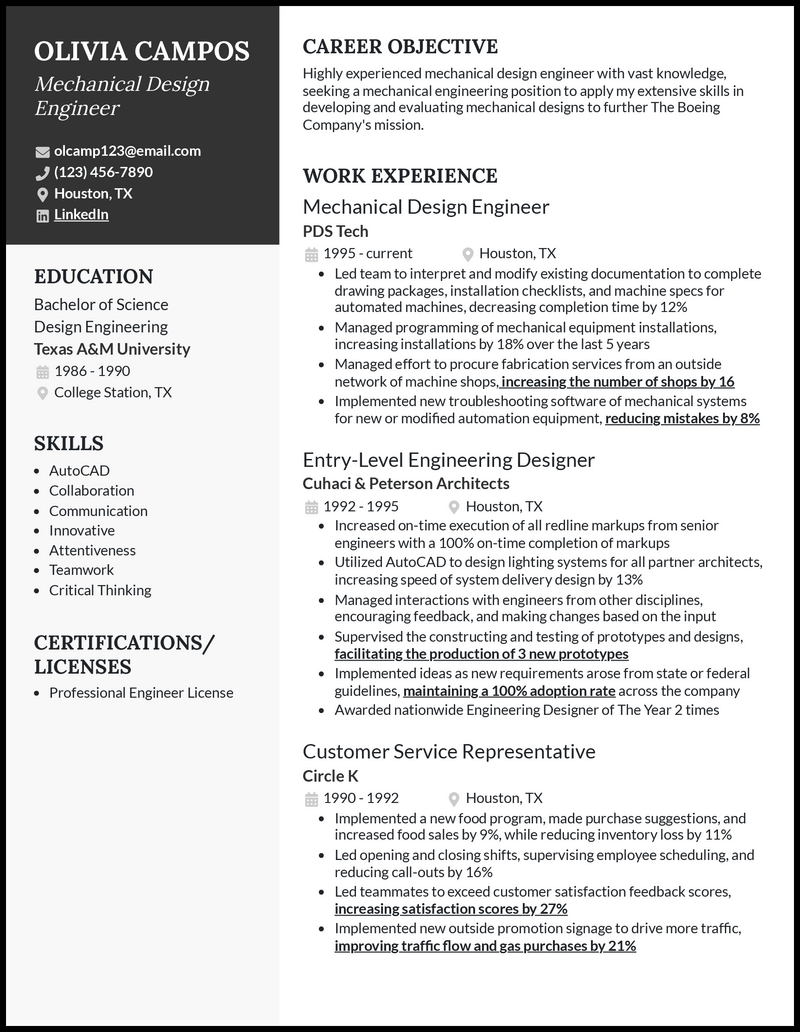As a mechanical design engineer, you’re no stranger to complex calculations and precise measurements. Your in-depth knowledge of engineering, combined with a deep understanding of physical principles, helps you create extraordinary designs.
You’ve worked on countless blueprints and documentation, but now, it’s time to put them aside for a moment because you’ll need an effective resume template of your own to score your next job.
Our mechanical design engineer resume examples are here to simplify the process for you. We’ll help you make a resume that accurately highlights all of your strengths!
Copy this text for your mechanical design engineer resume!
Kaida Kim
Labor and Delivery Nurse
kim.kaida@email.com
(123) 456-7890
Knoxville, TN
WORK EXPERIENCE
Labor and Delivery Nurse
East Tennessee Children’s Hospital
November 2019 – current
Knoxville, TN
– Used GE Corometrics fetal monitors to track and evaluate fetal heart rates for 450+ cases each year, ensuring accurate and timely intervention as needed
– Developed and implemented individualized care plans for high-risk pregnancies, decreasing complications by 77%
– Used the Siemens epoc Blood Analysis System to provide immediate blood gas, electrolyte, and metabolite results
– Oversaw the neonatal resuscitation program, ensuring staff certification and contributing to a 62% improvement in neonatal outcomes
Phlebotomist
Saint Thomas Health
October 2015 – October 2019
Nashville, TN
– Drew blood from an average of 70 patients per day while maintaining a less than 2% recollection rate
– Provided rapid bedside blood analysis and reduced turnaround times for results by 43% through the Abbott i-STAT System
– Coordinated with lab technicians to ensure prompt and accurate blood sample analysis
– Conducted over 200+ mobile blood drives and boosted blood donations by 54%
Medical Assistant
Vanderbilt University Medical Center
September 2012 – September 2015
Nashville, TN
– Managed 3,000+ patient appointments with McKesson EHR each year, increasing clinic efficiency by 25%
– Reduced patient wait times by 36% by implementing self check-in kiosks and managing patient flow
– Cleaned and sterilized medical equipment, maintaining compliance with safety and health regulations
SKILLS
– McKesson
– GE Corometrics
– Baxter Sigma Spectrum
– Masimo Root with Radius-7
– GE Healthcare CARESCAPE Monitor B650/B850
– Abbott i-STAT System
– Siemens epoc Blood Analysis System
EDUCATION
Bachelor of Science
Nursing
Vanderbilt University
2008 – 2012
Nashville, TN
LICENSES
– Certified Registered Nurse in Obstetrics (C-OB)
ACTIVITIES
Program Coordinator at the National Organization for Women (NOW), organizing events that promote women’s health and reproductive rights
What Matters Most: Your Engineering Skills & Design Experience

Being successful in your role is closely tied to your diverse skill set. From being a pro at various 3D modeling software to being a math whiz with a knack for creative thinking, you’ve got all the skills needed to transform a blueprint into a physical object.
It takes a lot to know how things work, and even more to know how to make them work better, or even to invent something new entirely. This is why filling out the “skills” part of your resume should be no problem, and you’ve got what it takes to make this section impressive.
While it’s important for you to translate complex innovations for a non-technical audience, your soft skills will have their chance to shine in the cover letter and the interview.
The secret recipe to successfully highlighting your engineering expertise is to focus on all your technical abilities. This includes staples, such as AutoCAD, but also things like an intimate knowledge of thermodynamics.
9 best mechanical design engineer skills
- AutoCAD
- Matlab
- SolidWorks
- ANSYS
- Rapid Prototyping
- Revit
- Thermodynamics
- Autodesk Inventor
- Fluid Mechanics
Sample mechanical design engineer work experience bullet points
In your role, each day brings a new challenge, from patenting innovative engines to meticulous design reviews. When you fill out your resume, it’s best to stray away from the day-to-day.
Saying that you “tested designs” or “worked on documentation” might be true, but it’s not the highlight of your career, which is what you want to focus on here.
Think of achievements that are closely tied to the skills you’ve listed, and add data to make them more tangible.
For example, say that you were able to increase the production rate by 17% by optimizing the design of mechanical components—the percentage is eye-catching and shows your true impact.
Here’s how you can do this in your resume:
- Used SolidWorks to design and optimize a new HVAC system for a 10-story building, reducing energy costs by 21%
- Delivered a complex conveyor system project 3 weeks ahead of schedule, saving 20% of the budget
- Reduced design errors by 13% by spearheading a system of monthly design reviews, resulting in over $75,000 in annual savings
- Introduced the use of finite element analysis via ANSYS, reducing prototype costs for heat transfer solutions by 19%
Top 5 Tips for Your Mechanical Design Engineer Resume
- Software is key
- Make sure to mention all the tools you’re proficient in. Focus on AutoCAD, SolidWorks, Matlab, ANSYS, CATIA, Creo Parametric, and other industry-specific tools. Bonus points if these programs are listed in the job description!
- Never re-use your resume
- Mechanical design engineering roles can vary wildly from one to the next, so make sure to tailor your resume to match the job. Swap skills and work experience bullet points in and out as needed. For example, if the company is in the automotive sector, mention your experience in building engine parts.
- Don’t forget your certification
- If you have the Professional Engineer (PE) certification, it’s worthy of inclusion, so pick a resume template that lets you easily add it.
- Be clever about your interpersonal skills
- With a host of technical skills to boot, you really don’t have space in your resume to list things like “creative” or “team player,” but slip them into your work experience. Mention instances of working with cross-functional teams of engineers or holding presentations for important clients.
- Show off your greatest designs
- Designing something from scratch is time-consuming, but so rewarding when your idea comes to life. Discuss your greatest designs in your resume and cover letter, be it a heat exchanger or a new pump, and elaborate on them during the interview.
Zone in on your engineering knowledge and try to look for transferable skills. For example, if you’re applying to a company in the aerospace sector, highlight your knowledge of safety standards and thermodynamics.
You can, but only if you update it for each company. Use it to quickly summarize your greatest accomplishments and describe how you’re hoping to grow in your new role.
Create a cover letter as an extension of your resume. For example, if you talked about developing a new gearbox design using CATIA, circle back to that in the cover letter and explain what you learned from the whole process.








